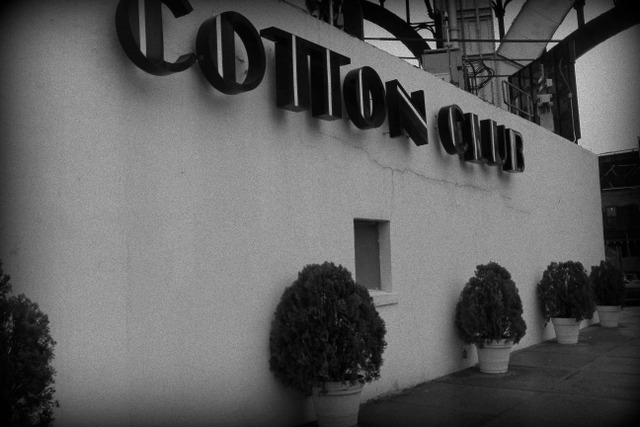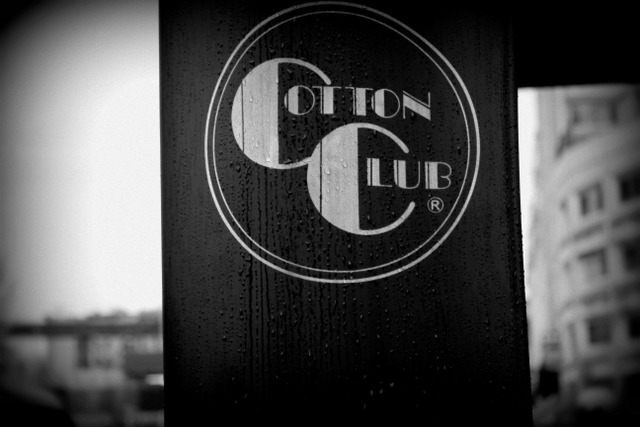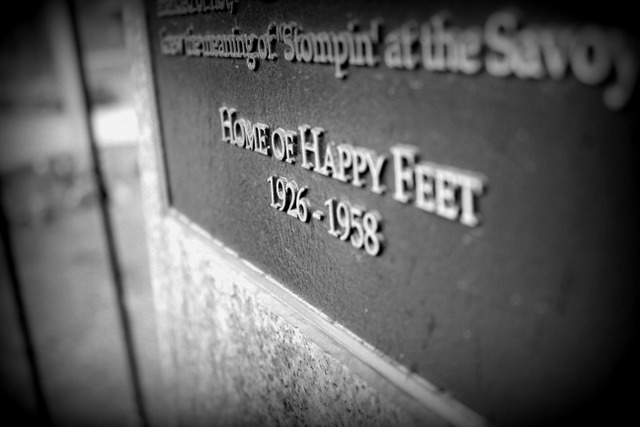
I entered college with three things: a love of poetry, a strong sense of Black Pride and a boyfriend. I left college with a BA in Writing and ethnic studies, and—perhaps in the typical Sarah Lawrence fashion—a girlfriend. During those four years I went on some sort of journey, the catalyst being a sudden dive into a group of academic, queer, and Black men and women. It’s a journey I am still on, and can’t exactly put into words. I was openly queer in high school, to anyone who would listen, as my grandfather (a Korean war vet who had raised me as a single father) had gone selectively deaf when I came out to him as bisexual. When I left college, I found myself with a better-informed sense of militancy and much more comfortable with the thing that had been haunting me for years: I am a lesbian.
There were obvious reasons I’d been worried all my life about ever calling myself the “L” word: religious family members or misguided classmates, and the understandable desire of every human being to fit in with the majority. But my habit of toting around boyfriends by day but spending nights between women’s legs pointed to something bigger, something deeper. It wasn’t until my senior year of college, when I found myself wanting to write about a jazz singer during the Harlem Renaissance, that I discovered Gladys Bentley, a woman blues singer who frequented Harlem speakeasies, romancing ladies with her alto voice, and modified lyrics to popular songs—all while wearing a tuxedo.

I’m sorry, what?
I remember staring at my computer screen, thinking about Baldwin and Langston Hughes—the only two Harlem Renaissance artists I could name who I knew were queer or at least comfortably rumored to be so. This led me to Countee Cullen, whose poems had sat on my bookshelf when I was a child. They were bought for me by my grandfather who must not have known the truth, or I could guarantee I would never have even set eyes upon the covers. They were all men. But here was Gladys, with her top hat and her Drag Queen back-up singers. And here I was, having never heard of her before this moment — not to mention having never known that Josephine Baker had dated Frieda Kahlo. Why was that?

It didn’t dawn on me until I came out to my family, and the resulting events introduced me to a lesbian cousin I never would’ve known I had. She was never spoken about, just as no one had mentioned that Langston Hughes was gay when we read his poems in elementary school. I was noticing a pattern.
If Queer people were invisible, Black Queer people were even more so.
This made it even harder to discuss. I grew up in the south Bronx, where the only people I knew to be gay were Latino/a. Specifically, there was one man who would smoke his cigarettes in the morning, standing in the doorway of the building across the street, draped in a pink bathrobe with his short, graying black hair slicked to shine; and two Puerto Rican girls who were my image of ‘butch’ for most of my life, with their boys’ cargo shorts, piercings and ponytails. I didn’t see — or perhaps I was guilty of perpetuating invisibility myself — any black lesbians until I was older, in Harlem. I saw my first studs and AGs, and I understood there was room for me, the Black girl who wasn’t straight.
I spent a lot of time in Harlem. I shopped on 125th street, ate at Amy Ruth’s, bought hoop earrings in Little Senegal and whenever possible, I’d see all the movies I could at Magic Johnson’s Theater. As a young spoken word poet, I dreamed of moving to Chicago, just to be around the space where the other half of the Harlem Renaissance took place. Even when someone doesn’t know the range of the artistic revolution that was the Harlem Renaissance, they know the name. They know writers like Claude Mckay or singers like Ethel Waters but they may not know them as Queer Black Americans. Why is this?
Harlem during the 20’s and 30’s wasn’t about “coming out”, and relationships were relatively open. Gay culture wasn’t segregated the way it is today — no “gay clubs” were needed. Homosexual and heterosexual people alike partied in the same venues; The Cotton Club, the Savoy and Rockland Palace all held Drag Balls as well as hosted many straight performances.

At times it seems like past-Queer Harlem had a better view of what queerness meant than we do today. Back then, if a woman slept with a woman, it didn’t necessarily make her a lesbian. In Josephine: A Hungry Heart, Jean Claude Baker speaks about how women performers often shared hotel rooms and had affairs. However, he does go on to say that if a woman flat-out refused a man she was derisively labeled a “bull dyke.” There is always a point where discrimination rears its ugly head. While there was visibility in Queer Harlem then, it’s now cloaked in invisibility. It took me so long to discover queerness in that time period that I had to teach myself about it.
These renaissance men and women were the heroes of people like my grandfather, people who might have completely written off their accomplishments had they known about their personal affairs. I wonder if the invisibility began there, as a ‘look the other way’ attitude. And did our Black heterosexual ancestors pass this on to us? Is this why Queen Latifah’s relationship with her personal trainer has gone so unnoticed by the general population? Is this why no one knew about Robyn, Whitney Houston’s rumored lesbian lover? Are we so willing to look stupid, as stupid as the onlookers in the juke joint as Shug Avery sings a love song to Celie? If we continue this, there will be no hope for a positive public image of a Queer Black person and we’ll be forced to swallow sad, offensive excuses for non-hetoronormativity, a la Nicki Minaj.
When Pariah came out, I was as happy as a couple spending their wedding night in a five-star hotel. I risked missing it just to wait until it was showing in Harlem, not even sure whether it would. If I was going to see the film (which I thought was lovely), I was going to see it in my ideal environment, surrounded by queer people of color. My love for Harlem as a community runs so deep that I cried when they built the first Starbucks — gentrification makes its huge mark. As being gay in America is primarily a “white thing” — the sort of flamboyant men you see in Bird Cage and the sort of butch women you see in Monster — I’m sure the gentrification will bring more queerness in the community. But once again, Black Queerness is moved to the side, out of sight and out of mind.

I have rather large dreams for myself: to become a well-known (okay, famous) Black, lesbian fantasy writer. I want to bring queer characters to the forefront, with stories that aren’t just centered on their sexuality. But it dawned on me when I spoke to my newly discovered gay cousin that one day I might be the one who isn’t spoken about, the leper of the family. “The one who ran off to Brooklyn with her girlfriend, who writes those books we don’t let our children read.” I’ve found a thriving Black Queer culture in Brooklyn, and on restless nights I tell myself we didn’t get wiped out of Harlem, we just moved, we migrated. We’re here, we’re queer, we’re not actually invisible.
It’s very hard to believe myself.
All images are courtesy of Siliah J “Sil” Nelson of F3ARL3SS PHOTOGRA4HY. siliahj [at] gmail [dot] com.
Special Note: Autostraddle’s “First Person” personal essays do not necessarily reflect the ideals of Autostraddle or its editors, nor do any First Person writers intend to speak on behalf of anyone other than themselves. First Person writers are simply speaking honestly from their own hearts.



I really love this piece. It’s very beautiful, and you managed to articulate things that I’ve never been able to find the proper words for.
I spent the past two years living in Harlem and never felt so invisible in my whole life. There isn’t much queerness in Harlem, of any race. You put into words what I’d been feeling, thank you. Also it was great to hear more about the history of the area, I wish I had known more about it while I was there.
Great article. Please keep writing.
hear, hear.
It is important that writers like Becca exist…and that articles like this get written, so that we can preserve our heritage…we are the keepers of the knowledge and we’ve got to pass it down so we don’t vanish.
Like.
i like this.
I should actually be writing my paper on queer culture in 1920s NYC right about now, and like, suffice to say this piece has inspired me to get to work. Fuck yeah tracing queer history
Please write those stories, and when you do, I promise to defend them as LITERATURE at the book discussions as opposed to “queer” or “black” lit, or whatever else gets invented to try to pigeonhole your work.
Thank you so much for this piece.
So so so much.
“If I was going to see the film (which I thought was lovely), I was going to see it in my ideal environment, surrounded by queer people of color.”
This so beautiful and true.
I really like this. Alot alot alot.
Sometimes I feel that to be a POC, or queer, or qpoc,p… Or anything that is not “normal” and constantly affirmed, is to be in constant want of spaces. Maybe we all dream of spaces where can be, just be, before we go to sleep.
Thank you all so much for the feedback!
I agree with Zana, in terms of dreaming of spaces. Since I came out to myself I have been seeking more and more opportunities to connect with Qpoc.
its rough!
@Sydney–I WOULD love it if the Huff Post published this. It’d be dope. I don’t know what the rules are in terms of publishing in more than one place but something like this shouldn’t be isolated for other queer people to read. It’s heterosexual people who often need to hear it.
Besides, Miss Huffington was an SLC grad!
Who knew? This piece should be in Huff Po or something. Time to blow the lid off this thing! sigh, or would that be counter productive?
Dear Internet Gods,
Thank you for this article.
Thank you for this author.
Thank you for this post.
For far too long, we have been talking about the historicized invisibility of black queerness, especially as the black community is viewed by cultural essentialists as being inherently homophobic.
But we are here. Black queers.
And we ain’t going no damn where.
Amen and Amen and Amen again.
And I’m not even Christian.
If one of your purposes in writing this was to make people think, then you’ve accomplished that to a really amazing extent. I don’t think I’ve thought as hard and long about something I’ve read recently as I have with this one. Really beautiful. Thanks for giving me something to think about that I wouldn’t normally experience.
This is a wonderful piece, very well-written and thoughtful. Thank you.
This is lovely. Thankyou.
Do you have any fantasy stories you’ve already written/published? I’d love to read them!
Thanks Guys! @Gabrielle, unfortunately nope. I’ve been a performance poet for like 6 years and just got into fiction a while ago–seriously at least. Within the year, however, I sincerely want to have an agent for this project I’m working on now–can’t stop, won’t stop hahah.
Amazing. Thank you so much for sharing.
Great Article Becca.
As a lesbian who is just getting the hang of being visible and having witnessed the product of invisibility this article reflects on, this problems is found in most communities with a vast majority of minorities.
It is the unspoken truths which our parent’s parents and so forth have passed down to us for generations.
It was a constant struggle for me as a Latina to be upfront about my sexual preference specially with my mother but it is something that we all have to fight for because I am a believer that in the long run it will make a lot of difference not only for myself but for next generation of LGBTQ.
I must say i’ve hung out around the Harlem area with women and unfortunately I still feel out of place and I’ve even encountered some serious homophobia…to think that a vast generation of queer folk has long been common in the area yet s*&^ like that still happens…SMH
BTW, the BK lesbian Scene is poppin’
Look forward to reading your fiction.
@Teresa, HI! What a surprise lol
I’ve experienced homophobia in Harlem as well and I am sure that few people realize the gay culture that used to strive there.
I’m not sure if it would make a difference if they did.
BK has been good to me :) And thank you for the support of my writing :)
Thank you for this lovely piece.
My partner and I have lived in Harlem for the last 4 years. Harlem has been accepting and kind to us. We are apart of a lovely gay/lesbian community that supports and nourishes us. We are not invisible, we are integrated.
:) I’m sincerely glad you’ve had the privilege of visibility while in Harlem. Regardless of how my family, the black community or Harlem has treated me, I love of them! :)
Thank you for sharing your journey. This is affirming to read especially after getting in the age old argument with my little brother about how unnatural homosexual life is. It feels as though straight black folks know what’s up and then they get amnesia. The visibility piece is key in places like Harlem. Im from Washington DC we are including my trans and gay men fam, here to stay. Keep writing and rockin out in Brooklyn
I really think this is the best piece I’ve read on this website. On a side note, can we be friends? I left Atlanta and moved to New York, and I feel like the norms of Black queerness have changed dramatically.
hahaha of course! My girlfriend and I are always looking for new friends. You can email me @ [email protected], its the easiest way to reach me and we can exchange numbers then :)
Nice job…. thought-provoking, hearfelt and photos that scream SILENCE….. You have been quiet entirely too long. WRITE-ON!
Great piece! I definitely think most queer people of color can relate to the long history of attempted erasure of our experience and existence. As someone who also loves harlem (went to Columbia undergrad and i fell in love with it completely), it has been sad that I have felt the need to move to Brooklyn for a move comfortable and out lifestyle.
WHile i know Harlem has a queer community, I have found it to be steeped in the social mores of the black middle class and somewhat conformist.
But I wanted to echo Iash’s point, Can we be friends? My girlfriend and I will be moving to Brooklyn in June (she’ll be coming from ATL) and it would be great to know some cool, black lesbians to invite over for dinner parties.
=)
haha thank you so much. Definitely shoot me an email soon @[email protected] We’ll exchange numbers.
My gf and I are always looking for new couples to chill with :)
Beautifully written, I think it tells a story many of us have lived. Feeling invisible, even in our own communities….
I loved this essay, I hope you write more. It rekindled my love of poetry from the Renaissance, which I also studied around 10 years ago. I’m in the UK, and I have only visited Harlem. So thank you for the insight that I never got from my studies or my visit – to hear what life is like now, for queer folks in Harlem.
This whole series of Here/Queer has been illuminating.
i let this post sit unread until i could actually sit down and read it but how i’m not sure if i’m sad i didn’t read it earlier or happy that i waited until i could give it all the time it deserves. this was just so great.
I love this post. I only found it now but as someone who isn’t even from the U.S., it was a really interesting read and movingly written. Thank you for sharing your experiences with us! :)
THIS POST IS EVERYTHING!!!
Lol I know I’m late. :)
Its okay! Thank you for reading and relating :)
Pingback: queer harlem renaissance jams | African American Literature and Culture
Great article to read on.